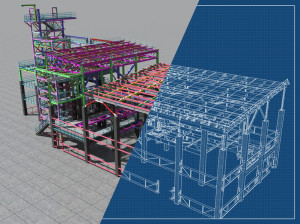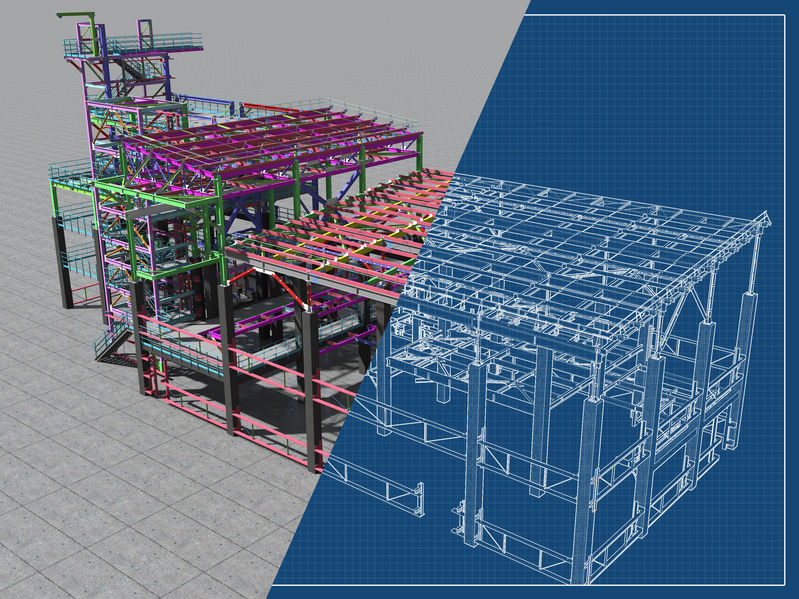Enhancing construction efficiency with BIM in paving projects
 In the fast-paced construction world, efficiency is critical to successful project completion. One technological advancement that has revolutionized the construction industry is Building Information Modeling (BIM). With its ability to streamline processes, improve collaboration, and minimize errors, BIM has become an indispensable tool for paving projects. In this blog post, we will explore how BIM enhances construction efficiency in paving projects and how McNeil Engineering can help contractors, owners, and architects maximize the benefits of BIM in their projects.
In the fast-paced construction world, efficiency is critical to successful project completion. One technological advancement that has revolutionized the construction industry is Building Information Modeling (BIM). With its ability to streamline processes, improve collaboration, and minimize errors, BIM has become an indispensable tool for paving projects. In this blog post, we will explore how BIM enhances construction efficiency in paving projects and how McNeil Engineering can help contractors, owners, and architects maximize the benefits of BIM in their projects.
Streamlining design and planning
The initial stages of a paving project involve meticulous design and planning. BIM plays a vital role in streamlining these processes. By creating a digital representation of the project, BIM allows designers and planners to visualize the entire scope, identify potential clashes, and make informed decisions before the ground is broken.
With BIM, designers can create accurate 3D models of the pavement, considering factors such as grading, cross-sections, and drainage. This enables the identification of potential issues, such as inadequate slope for water runoff or conflicting utility lines, at an early stage. By addressing these issues proactively, costly delays and rework can be minimized.
BIM provides designers and planners with a comprehensive visualization of the entire pavement project. This allows them to make informed decisions based on accurate and detailed information. By clearly understanding the project scope and potential challenges through BIM, designers, and planners can make adjustments, refine the design, and optimize the pavement layout to meet project goals and requirements.
Enhancing collaboration and communication
Effective collaboration and communication among stakeholders are crucial for the success of any construction project. BIM provides a centralized platform where architects, engineers, contractors, and owners can collaborate and share information seamlessly.
Through BIM, all project participants can access a shared model, ensuring everyone is on the same page. Design changes or modifications can be made in real time, and the impact can be immediately communicated to all parties involved.
By presenting the pavement design visually, BIM allows stakeholders, such as owners, community members, or project sponsors, better to understand the design intent and the overall project scope. They can visualize how the pavement will interact with surrounding structures, landscapes, and utilities, leading to more transparent communication and more informed decision-making.
The 3D visualization also helps stakeholders identify potential issues or concerns that might not be evident in traditional 2D plans. This early engagement and improved understanding of the project can lead to better collaboration, reduced conflicts, and increased satisfaction among all parties involved.
Additionally, BIM facilitates clash detection between different systems, such as pavement, underground utilities, and structures. BIM can help detect if there is a conflict between the proposed pavement layout and existing utility lines or facilities. Identifying clashes early on can resolve conflicts before construction commences, saving time and resources. Visualizing the project in 3D also improves communication with stakeholders with limited technical expertise, enabling them to understand the design intent better.
Optimizing construction and maintenance
During the construction phase, BIM continues to enhance efficiency in paving projects. By generating detailed construction schedules and sequences, BIM allows for optimized resource allocation, reducing idle time and improving productivity. Contractors can effectively plan and coordinate tasks, ensuring a smooth workflow and improved construction site productivity.
Furthermore, BIM aids in the coordination of construction activities, ensuring that different trades work in harmony. For example, BIM can help determine the precise location of utilities, enabling accurate excavation and installation without the risk of damaging existing infrastructure. This level of coordination minimizes potential conflicts and delays, leading to more efficient construction processes.
Beyond construction, BIM also offers significant benefits for ongoing maintenance. By leveraging BIM for this ongoing maintenance, owners can effectively manage the performance and condition of the pavement. They can make data-driven decisions, optimize maintenance budgets, and ensure the longevity of the infrastructure. With an accurate digital representation of the pavement, owners and facility managers can also easily access information on maintenance requirements, including repair schedules, materials used, and warranty details. This knowledge enables proactive maintenance planning, prolonging the pavement’s lifespan and minimizing future disruptions.
Building Information Modeling (BIM) has become indispensable for enhancing construction efficiency in paving projects. From streamlining design and planning to optimizing construction and maintenance, BIM improves collaboration, minimizes errors, and saves time and resources. At McNeil Engineering, we understand the importance of leveraging BIM for successful project delivery. With our expertise in 3D modeling, conflict coordination, and site work, we are committed to helping contractors, owners, and architects unlock the full potential of BIM. Contact us today to discuss how McNeil Engineering can assist you in maximizing the benefits of the BIM process.
At McNeil Engineering, our goal is to aid contractors, owners, and architects in meeting the requirements of the BIM process as prescribed in their contracts. We provide 3D modeling for conflict coordination, architectural components, structural framing, and site work. Call us today at 888-303-7700 to discuss how we can help you succeed using the BIM process.

